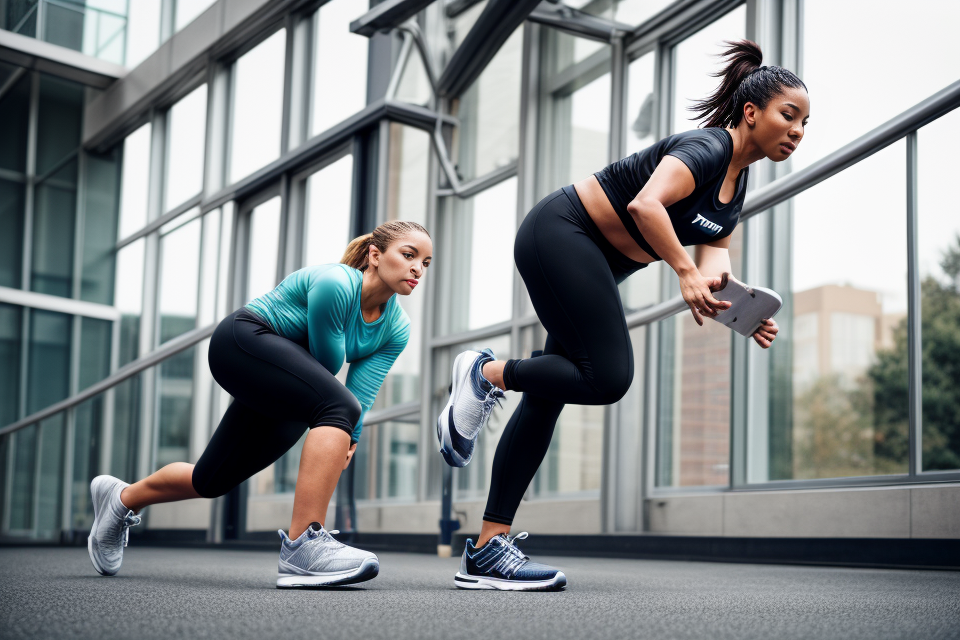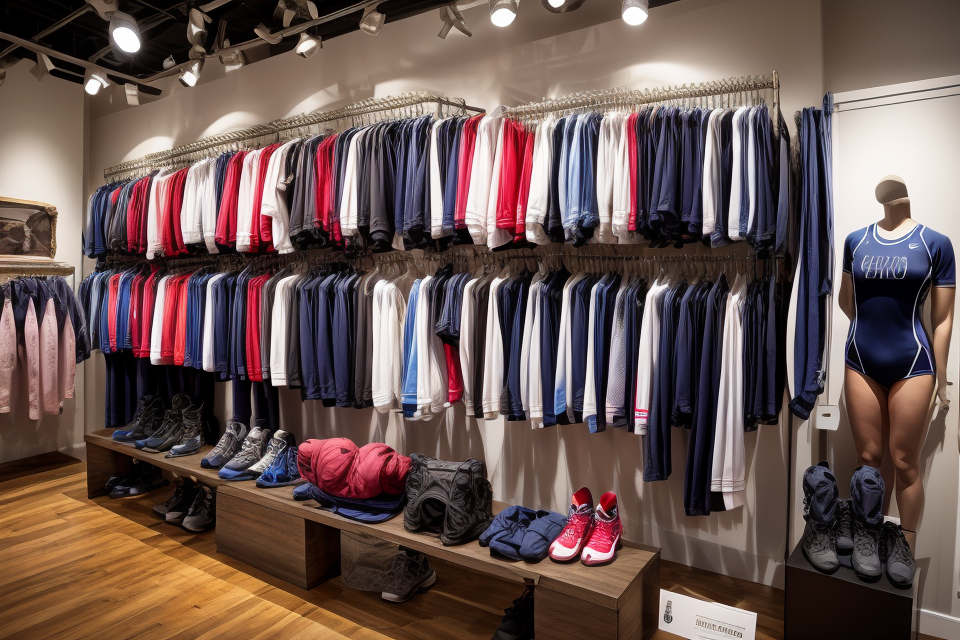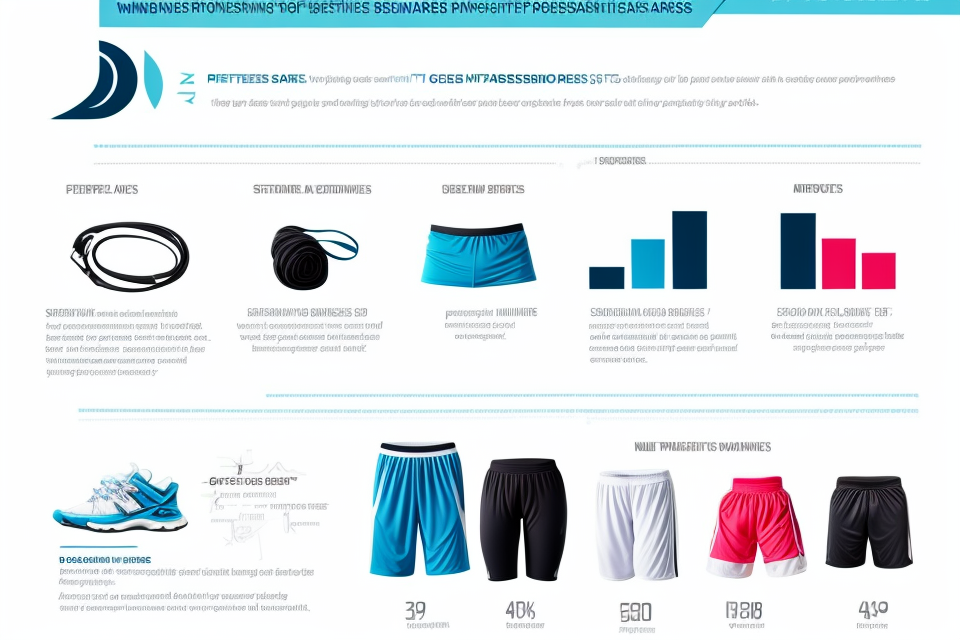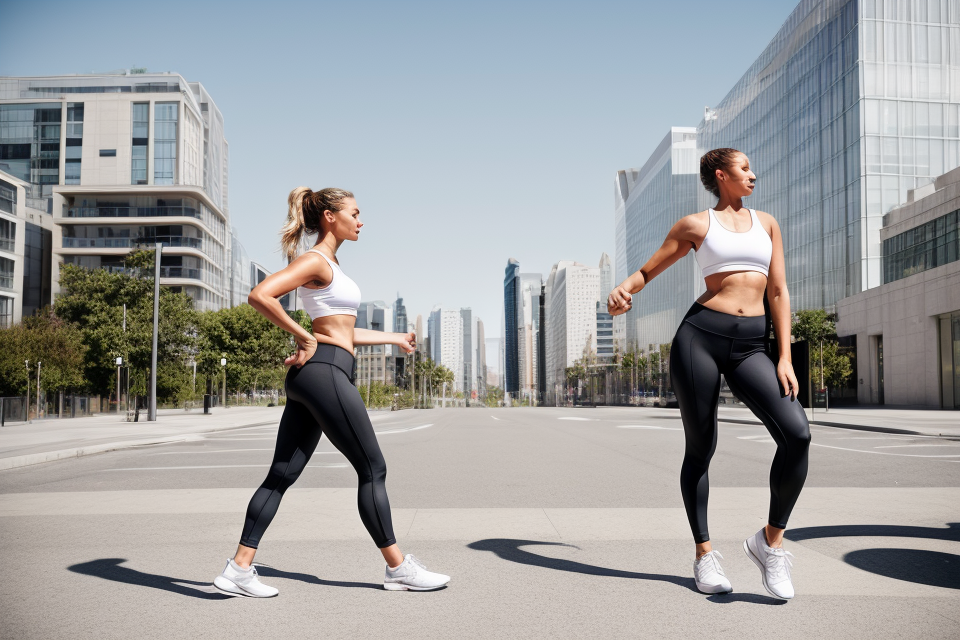Sneakers have been a staple in fashion for decades, and their popularity has only continued to rise. With the rise of activewear, there has been much debate over whether sneakers can be considered a part of this category. Activewear is clothing designed for physical activity, and many people believe that sneakers fall into this category. However, others argue that sneakers are more of a fashion statement than a functional piece of activewear. In this comprehensive guide, we will explore the different opinions on this topic and provide a definitive answer to the question: Are sneakers considered activewear?
Yes, sneakers are considered activewear as they are designed for physical activity and exercise. They provide support, cushioning, and stability for the feet during various sports and workouts. Activewear refers to clothing and footwear specifically designed for physical activity, and sneakers fit into this category. Whether you’re running, lifting weights, or playing basketball, sneakers are a crucial part of your activewear wardrobe. They come in a variety of styles, materials, and colors, and can be worn for both athletic and casual occasions.
The Debate on Sneakers as Activewear
What is Activewear?
Activewear refers to clothing that is designed for physical activity or exercise. This type of apparel is typically made from moisture-wicking, breathable materials that are designed to keep the body dry and comfortable during movement. Activewear is often associated with athletic activities such as running, cycling, and yoga, but it can also be worn for everyday wear.
Common examples of activewear include:
- Athletic shoes
- Workout clothes such as leggings, shorts, and tank tops
- Yoga mats
- Water bottles
- Fitness trackers
- Resistance bands
- Weightlifting gloves
- Sweat-wicking t-shirts and socks
Overall, activewear is designed to provide comfort, support, and functionality during physical activity. It is important to note that not all clothing that is worn during physical activity is considered activewear. For example, jeans and dress shoes are not typically considered activewear, as they are not designed for movement and may hinder performance.
The Controversy Over Sneakers as Activewear
Different Perspectives on the Matter
The debate over whether sneakers can be considered activewear is a contentious issue that has generated various perspectives. On one hand, some argue that sneakers are not activewear because they are primarily designed for casual wear and not for participating in sporting activities. They claim that activewear should only include clothing items that are specifically designed for physical activity, such as workout clothes and athletic shoes.
On the other hand, others argue that sneakers can be considered activewear because they are designed for movement and support the feet during physical activity. They point out that sneakers are often worn during sports and other activities, and therefore should be considered a part of activewear.
The Significance of the Debate
The debate over whether sneakers are considered activewear has significant implications for the fashion industry and consumers. For fashion designers and brands, the distinction between activewear and casual wear is important as it affects the design and marketing of their products. Additionally, consumers who are looking to purchase activewear may be confused by the different opinions on what constitutes activewear, leading to uncertainty in their purchasing decisions.
Overall, the debate over whether sneakers are considered activewear is a complex issue that requires careful consideration of the different perspectives and implications involved.
The History of Sneakers as Activewear
The Origin of Sneakers
The Evolution of Sneakers
Sneakers have come a long way since their inception in the late 19th century. Originally designed as a type of plimsoll shoe, they were primarily used for athletic purposes. The first mass-produced sneakers were made by the U.S. Rubber Company in 1892, and were known as “sneakers” because of their ability to allow the wearer to move quietly.
The Original Purpose of Sneakers
The original purpose of sneakers was to provide athletes with a comfortable and durable shoe that could withstand the demands of their sport. The first sneakers were made from canvas and rubber, and were designed to be lightweight and flexible. They quickly became popular among athletes, and were worn by runners, basketball players, and other athletes in a variety of sports.
Over time, sneakers evolved to include a range of different materials and designs, and became a popular fashion statement in their own right. Today, sneakers are worn by people of all ages and backgrounds, and are considered a staple of modern fashion. However, despite their widespread popularity, there is still some debate over whether sneakers can be considered a type of activewear.
The Transition of Sneakers to Activewear
- The changing role of sneakers in fashion
In the past, sneakers were primarily associated with athletic activities and were not considered a fashion statement. However, as fashion trends have evolved, sneakers have transitioned from being a utilitarian item to a fashion statement.
- The impact of athleisure on the classification of sneakers
The rise of athleisure has played a significant role in the transition of sneakers from being solely considered activewear to also being classified as fashion footwear. The blending of athletic and leisure wear has resulted in sneakers being worn in a variety of settings, including in formal and casual attire.
This shift in the classification of sneakers has been driven by the growing popularity of streetwear and the influence of celebrities and influencers who have popularized the wearing of sneakers as a fashion statement. Additionally, the increased availability of high-quality materials and innovative designs has also contributed to the shift in the classification of sneakers.
As a result of these factors, sneakers are now commonly considered as part of the activewear category, but also as a fashion statement and are worn in a variety of settings.
The Criteria for Classifying Sneakers as Activewear
Fit and Functionality
When considering whether sneakers can be classified as activewear, fit and functionality are crucial factors to evaluate. The following aspects are essential to discuss:
- The importance of fit and comfort in activewear
- A well-fitting and comfortable activewear garment is essential for optimizing performance during physical activities.
- Comfort is vital in activewear because it reduces distractions and allows the wearer to focus on their movements.
- A good fit ensures that the garment stays in place and does not restrict movement, which is crucial for optimal performance.
- The functionality of sneakers for different activities
- Sneakers are designed for a wide range of activities, including running, jogging, walking, hiking, and even casual wear.
- Different types of sneakers have different features that cater to specific activities. For example, running sneakers have a lot of cushioning and a flexible sole for optimal movement during long runs.
- Hiking sneakers, on the other hand, have a more durable sole and better grip for hiking on various terrains.
- Casual sneakers are designed for everyday wear and often have a more fashionable design, but they may still have some functional features such as good arch support.
In conclusion, sneakers are designed with specific activities in mind, and their functionality depends on the type of activity they are intended for. Fit and comfort are also essential factors in determining whether sneakers can be classified as activewear.
Material and Design
The Role of Materials and Design in Activewear
In the world of fashion, activewear is a term used to describe clothing and footwear designed for athletic activities. The materials and design of a piece of clothing or footwear play a crucial role in determining whether it can be classified as activewear. In this section, we will explore the importance of materials and design in activewear, particularly in the context of sneakers.
Materials Used in Activewear
Activewear is designed to be comfortable, durable, and functional. The materials used in activewear are often breathable, moisture-wicking, and lightweight. Common materials used in activewear include cotton, polyester, nylon, and spandex. These materials are designed to move with the body, allowing for freedom of movement during physical activity.
Design Elements of Activewear
The design of activewear is also critical in determining its suitability for athletic activities. Activewear is designed to be functional, comfortable, and supportive. Common design elements include:
- Padding and support for areas such as the knees and elbows
- Adjustable straps or Velcro closures for a customized fit
- Reflective materials for increased visibility in low-light conditions
- Water-resistant materials for activities such as running or cycling
The Influence of Technology on Sneaker Design
Advancements in technology have led to significant changes in sneaker design. New materials and manufacturing techniques have allowed for the creation of lighter, more comfortable, and more supportive sneakers. Innovations such as air cushioning and gel inserts have revolutionized the world of sneakers, providing unparalleled comfort and support for athletes.
Conclusion
In conclusion, the materials and design of sneakers play a crucial role in determining whether they can be classified as activewear. Activewear is designed to be comfortable, durable, and functional, and the materials and design elements used in sneakers reflect these principles. Advancements in technology have led to significant changes in sneaker design, providing athletes with innovative features such as air cushioning and gel inserts. Whether or not sneakers can be considered activewear ultimately depends on their materials, design, and intended use.
Durability and Versatility
- The importance of durability and versatility in activewear
- Activewear is designed to withstand the demands of physical activity, and durability is a critical factor in its performance.
- Durable materials and construction ensure that activewear can withstand the wear and tear of regular use, while also providing support and protection during physical activity.
- Versatility is also an important consideration in activewear, as it allows individuals to use the same piece of clothing or equipment for a variety of different activities.
- The range of activities and occasions for which sneakers can be worn
- Sneakers are versatile footwear that can be worn for a wide range of activities, from running and hiking to casual wear.
- Their durability and comfort make them suitable for everyday wear, as well as for more specialized activities such as fitness training and sports.
- Additionally, sneakers can be worn with a variety of different outfits, making them a versatile choice for a range of occasions.
The Impact of Sneakers as Activewear on Society and Culture
The Popularity of Sneakers as Activewear
- The influence of popular culture on the popularity of sneakers
- The rise of sports culture and athletic performance
- The evolution of sneakers from sports equipment to fashion statement
- The impact of sports celebrities and their endorsements on sneaker popularity
- The impact of sneaker collecting and reselling on popularity
- The allure of limited edition and exclusive sneakers
- The role of sneaker culture in driving the secondary market
- The rise of sports culture and athletic performance
- The impact of social media on the trend
- The role of social media platforms in promoting sneaker culture
- The rise of sneaker influencers and their impact on consumer behavior
- The use of social media as a platform for sneaker releases and promotions
- The impact of social media on sneaker trends and fads
- The role of social media in driving trends and creating fads
- The influence of social media on the fast-paced nature of sneaker fashion.
- The role of social media platforms in promoting sneaker culture
The Fashion Industry and Sneakers as Activewear
- The role of the fashion industry in the promotion of sneakers as activewear
- The increasing trend of athletic fashion in the fashion industry
- The rise of sneaker culture and its influence on fashion trends
- The collaboration between fashion designers and sneaker brands
- The effect on the traditional fashion industry
- The blurring of lines between activewear and fashion
- The impact on traditional sportswear brands
- The emergence of new fashion sub-genres
In recent years, the fashion industry has played a significant role in promoting sneakers as activewear. The rise of athleisure and sneaker culture has had a profound impact on the fashion industry, leading to a blurring of the lines between activewear and fashion. Traditional sportswear brands have had to adapt to this changing landscape, while new fashion sub-genres have emerged as a result.
One of the main drivers of this trend has been the increasing popularity of athletic fashion. As more people have become interested in fitness and health, there has been a growing demand for clothing that is both functional and stylish. Sneakers have been at the forefront of this trend, with many people choosing to wear them as their primary form of footwear, even when they are not engaged in sports or other physical activities.
The rise of sneaker culture has also had a significant impact on fashion trends. Sneakerheads, or individuals who collect and wear sneakers, have become influential figures in the fashion industry. They have helped to drive the popularity of certain sneaker models and have even influenced the designs of some fashion brands. As a result, sneakers have become a key component of many fashion collections, with designers incorporating them into their runway shows and collections.
Another factor that has contributed to the promotion of sneakers as activewear has been the collaboration between fashion designers and sneaker brands. Many fashion designers have partnered with sneaker brands to create limited edition sneaker models that are designed to appeal to fashion-conscious consumers. These collaborations have helped to raise the profile of both the fashion designer and the sneaker brand, while also providing consumers with unique and highly sought-after sneaker models.
The impact of sneakers as activewear on the fashion industry has been significant. Traditional sportswear brands have had to adapt to this changing landscape, while new fashion sub-genres have emerged as a result. The blurring of the lines between activewear and fashion has created new opportunities for fashion designers and sneaker brands alike, and it is likely to continue to shape the fashion industry in the years to come.
The Health and Fitness Community and Sneakers as Activewear
- The impact of sneakers as activewear on the health and fitness community
- The benefits and drawbacks of sneakers as activewear for fitness
Sneakers have become an integral part of the health and fitness community. They have evolved from being just a fashion statement to a functional footwear for athletes and fitness enthusiasts. In recent years, sneakers have gained significant popularity as activewear due to their ability to provide comfort, support, and flexibility during workouts. However, there are varying opinions about the role of sneakers in the health and fitness community.
The Benefits of Sneakers as Activewear
One of the primary benefits of sneakers as activewear is their ability to provide comfort and support during workouts. Many sneakers are designed with advanced technologies such as cushioning, arch support, and motion control to help reduce impact and prevent injuries. Additionally, sneakers can help improve performance by providing a stable and secure footing during high-intensity activities such as running, jumping, and quick changes of direction.
Another benefit of sneakers as activewear is their versatility. Sneakers can be worn for a wide range of activities such as running, lifting weights, cross-training, and even casual wear. They are also available in various styles, colors, and materials to suit individual preferences and needs. The ability to wear sneakers for multiple activities makes them a practical choice for individuals who lead an active lifestyle.
The Drawbacks of Sneakers as Activewear
Despite the benefits of sneakers as activewear, there are also some drawbacks to consider. One of the main concerns is the potential for overuse injuries. Overuse injuries can occur when individuals wear sneakers for activities that they are not designed for, such as wearing running shoes for long-distance hiking or wearing basketball shoes for weightlifting. Wearing the wrong type of sneaker for a particular activity can lead to pain, inflammation, and even permanent damage to the feet, ankles, and knees.
Another drawback of sneakers as activewear is the potential for poor biomechanics. Sneakers are designed to provide support and stability, but they can also limit natural movement patterns if they are not worn correctly. Improper fitting, lack of flexibility, and wearing sneakers beyond their intended lifespan can all contribute to poor biomechanics and increased risk of injury.
In conclusion, sneakers have become an essential part of the health and fitness community as activewear. They offer comfort, support, and versatility for a wide range of activities. However, it is important to consider the potential drawbacks of sneakers as activewear and ensure that they are worn correctly for the intended activity to avoid injury and promote optimal performance.
FAQs
1. What is activewear?
Activewear refers to clothing designed for physical activity, such as workout clothes, athletic wear, and sportswear. Activewear typically includes moisture-wicking fabrics, stretchy materials, and functional features like pockets and adjustable closures.
2. What is considered activewear?
Activewear can include a wide range of clothing items, such as t-shirts, shorts, leggings, sweatpants, hoodies, jackets, and more. It can also include accessories like headbands, wristbands, and sunglasses.
3. Are sneakers considered activewear?
Sneakers are often considered a type of activewear, as they are designed for physical activity and can provide support, cushioning, and other features that are beneficial for sports and exercise. However, not all sneakers are created equal, and some may be more suitable for certain activities than others.
4. What makes sneakers suitable for activewear?
Sneakers that are suitable for activewear typically have features that support comfort, durability, and performance. These may include a sturdy sole, good arch support, a cushioned interior, and a non-slip grip. They may also be made from materials that are breathable and moisture-wicking, such as mesh or synthetic fabrics.
5. Can sneakers be worn for everyday wear?
Yes, sneakers can be worn for everyday wear, depending on the style and design. Some sneakers are designed for fashion and may not have the same level of support and performance as sneakers designed specifically for sports and exercise. However, many sneakers are versatile and can be worn for both active and casual occasions.
6. Are all sneakers considered athletic shoes?
Not all sneakers are considered athletic shoes. While some sneakers are designed specifically for sports and exercise, others may be designed for fashion or casual wear. Athletic shoes typically have features that support performance and comfort during physical activity, such as good arch support, a sturdy sole, and a cushioned interior.
Do not wear any of these sneakers in the winter
https://www.youtube.com/watch?v=gI3V4del-j0



